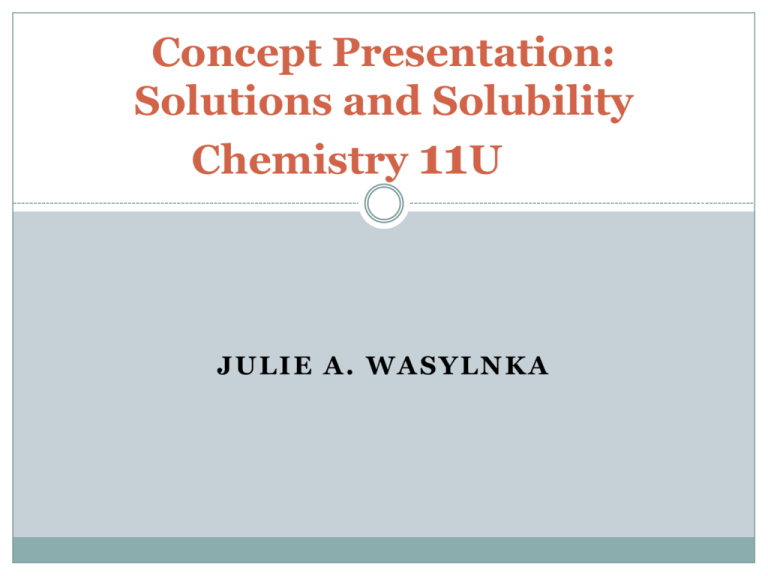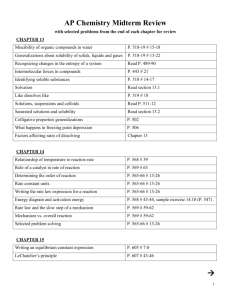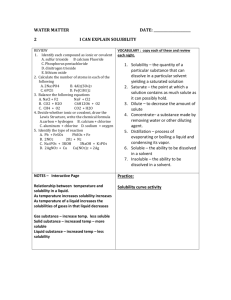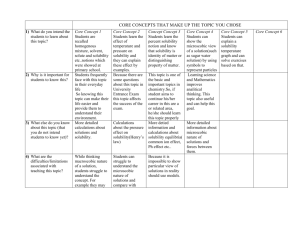Concept Presentation: Solutions and Solubility SCH3U
advertisement

Concept Presentation: Solutions and Solubility Chemistry 11U JULIE A. WASYLNKA Outline of Presentation Background Information on solutions and solubility Curriculum placement Overall and specific expectations Lesson sequence/teaching strategies (A&E embedded) Common misconceptions STSE References Background Information Big Ideas from the Curriculum Properties of solutions can be described qualitatively and quantitatively, and can be predicted. Living things depend for their survival on the unique physical and chemical properties of water. People have a responsibility to protect the integrity of Earth’s water resources Background Information Why study solutions? The majority of chemical processes are reactions that occur in solution. Important industrial processes often utilize solution chemistry. "Life" is the sum of a series of complex processes occurring in solution. Air, tap water, beverages, and household cleaners are common examples of solutions (Lagowski, 2004). Curriculum placement Matter and Bonding Chemical reactions Stoichiometry Solutions Gases September Previously learned concepts essential for success: Intermolecular forces Bonding/lewis structures Atomic radius/ionic radius Stoichiometry June Curriculum expectations Overall Specific expectations Lesson 1 Lesson 2, 4 Lesson 3 Lesson 5 ,6 Lesson Sequence 1) Unique properties of water and case study 2) Introduction to solutions 3) Factors affecting solubility and rates of dissolving 4) Factors affecting solubility part II 5) The solubility rules 6) Mystery compounds mini-lab Lesson 1: Case study The use of bottled water and its impact on the environment Demos on the properties of water Show video clip Put students in teacher-chosen groups Distributes case study Briefly discusses what students will be doing MI: Interpersonal, Logical A for L: Class discussion and observation Class management of the case study Step Task Time (min) 1 Read Part I of the case. 5 2 Discuss Sally’s mother’s dilemma, using it as a tool to direct class discussion to the background information in Part II 3 Read Part II of the case. 4 Groups discuss the questions at the end of Part II— have them prepare answers to turn in. 15-20 5 Class discussion—emphasize the interrelatedness of the issues. 20 10-15 5 Lesson 2: Introduction to Solutions Introductory powerpoint slides Review of terminology (solution, soluble, etc.) Types of solutions (solid – liquid, liquid-liquid etc.) - Video Clip: http://www.mhhe.com/physsci/chemistry/essential chemistry/flash/molvie1.swf Mini-labs MI: Visual, Tactile, Auditory, Interpersonal A for L: Exit pass Lesson 3: Factors affecting Solubility and Rates of dissolving Factors affecting solubility of compounds (temperature, pressure and nature of solute/solvent) Review intermolecular forces and introduce ion-dipoles Rates of dissolving (agitation, particle size, temperature) Polarity and solubility mini-lab MI: Tactile, Logical, Interpersonal, Visual, Kinesthetic A for L: Class observation/ discussion Lesson 4: Factors affecting Solubility II: Polar and non-polar solvents mini-lab Substance Water soluble (S, SS, NS) urea iodine Ammonia (dilute) naphthalene copper(II) sulfate sodium chloride ethanol A as L: Peer assessment Oil soluble (S, SS, NS) Lesson 5: The Solubility Rules, Part I Discussion on atomic size and charge of ions (socratic) How to use solubility tables Mini-Lab on known precipitation reactions MI: Interpersonal, Visual, Tactile, Logical A for L: Exit pass Lesson 6: The Solubility Rules, Part II Teacher Review solubility rules (veritech) Mini-lab with unknown compounds (A of L: structured/guided inquiry) DI Preconstructed data table or ask them to construct their own data tables Hints with the analysis Greater number of unknowns (challenge) Lab Safety Wear goggles when performing labs/mini-labs. Dispose of hazardous chemicals in the appropriate chemical waste containers Misconceptions with this topic: #1 Difficulties determining whether a solvent/solute is polar or non-polar Strategies Review concepts of intermolecular forces Have students draw out lewis structures of the solvents D.I. Students can build the models Misconception # 2 True or false: Increasing the temperature of a solution increases the solubility of solid and gases solutes. False: • The solubility of gaseous solutions decreases with increasing temperature. Suggested Teaching Strategies • Demo with carbonated beverages Misconception #3 Solubility tables are difficult to read Suggestions Students create their own tables Pneumonic? “CHOPS NAAA.” Solubility is explained from simple physical principles Coulomb’s Law Atomic radii Misconception #4 Dualistic treatment of solubility - Substances are only classified as soluble or insoluble, with no mention of the range of solubility values Suggestions More solubility data is included early in the discussion STSE Water purification/Waste water treatment IV solutions Air quality Reactions of the human body occur in solution Metal alloys: brass, bronze, steel Acknowledgements Lakshmi Janine Marty All my colleagues References Blake, B. 2003. J. Chem. Ed. Solubility Rules: Three Suggestions for Improved Understanding May, Lindsay Jessica Kotke, and Charles R. Bomar, But It’s Just a Bottle of Water... University of Wisconsin–Stout , 2006. National center for case study teachng in Science. http://www.sciencecases.org/bottled_water/bottled_water.asp “ Chemistry. Foundations and Applications.” Lagowski, J. J. 2004. http://findarticles.com/p/articles/mi_gx5216/is_2004/ai_n19132971/ ?tag=content;col1. Retrived July 16, 2010. McGraw Hill Higher Education (Solvation Animation) http://catalogs.mhhe.com/mhhe/home.do References Solubility Rules and the Mystery Solutions. Ohio Department of Education. http://ims.ode.state.oh.us/ODE/IMS/Lessons/Content/CSC_LP _S06_BA_L11_I01_01.pdf http://www.nclark.net/molecular_polarity_and_solubility_lab/ doc http://dwb.unl.edu/Chemistry/MicroScale/MScale26.html#TG %20Description The Water bottle problem: http://www.youtube.com/watch?v=flTbLnn5w_0 http://www.northland.cc.mn.us/biology/Biol ogy1111/animations/dissolve.html




